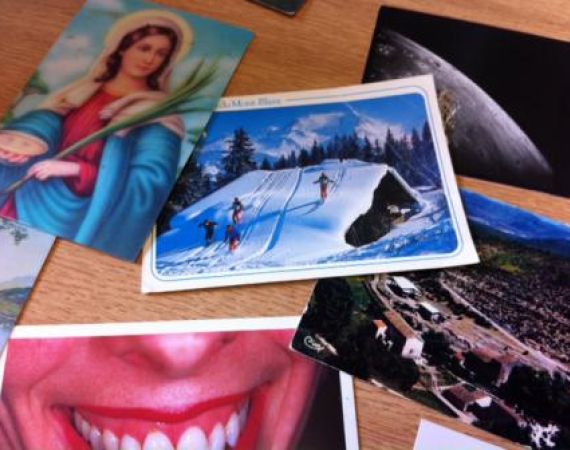Posted on Thu 23 Jun 2011
Postcards
After a really interesting and constructive work-in-progress meeting last Friday, we went away and reassessed our ideas. In response to questions about how people would know what the jukebox is and how to use it, we thought a lot more about the aesthetics and how to effectively embellish it to make…

Posted by
After a really interesting and constructive work-in-progress meeting last Friday, we went away and reassessed our ideas. In response to questions about how people would know what the jukebox is and how to use it, we thought a lot more about the aesthetics and how to effectively embellish it to make it more attractive and easier to understand. We started to think about an end-of-the-pier style with signage around the place where it's set up, an awning a bit like a deck chair and possibly a flashing sign like an old penny arcade machine. One style reference we have been looking at is The Museum of Everything in London.
In terms of the story, we had been working on one story; The Shelf Beneath your Eyes. After the meeting we revisited one of our previous projects, The Car Show. Our approach with thatshow was to come up with numerous short stories/ideas/experiences. The only constraints were that they had to take place in a car and they had to be short(less that 15mins max). We suddenly realised that the Jukebox was a similar beast. What we needed though were the constraints, the things about the Jukebox that make it what it is, like the windscreen, radio etc in a car.
Our first thought was tocreate a character who introduces and guides you through all the experiences. We imagine this voice would be like a kind of ringmaster.
We then began on Tuesday this week to really deconstruct the tools we have chosen to include in the jukebox and how best to exploit their potential. The three elements that willcombine to make the experiences are audio (usually binaural), top downprojection and RFID. The RFID is the bit that we are really new to. One of the main things it offers is the chance for audience members to make a choice.
This developed into a new concept for the Jukebox that we now hope to take forward.
With this new concept, each JukeBOX WILL now offer audiences a choice of stories. The simple construct ofthose experiences would be something like this:
- Responding to instructions written or projected on the JukeBOX, audiences call a number and hear a recorded message from the 'ringmaster'. He introduces himself and welcomes you to the Theatre JukeBOX. Hello, I am William Grimaldi, ringmaster, your host, theatre manager and keeper of the Jukebox. Welcome. The drawer should now be open. (It pings open?). Take a look inside. Touch the contents, pick them up. Turn each one over in your hands, smell them , feel them, look at them closely and when you are ready I want you to choose one. You can only have one, so choose carefully. When you are ready place it on the table (there is a projection to show you where to put your chosen item).
Each JukeBOX will have a different theme. The choices of items inside the drawer will follow that theme. Here are a few examples of choices/themes:
- Books: you choose a book from a very small library.Stories are projected into the books.
- Music: could choose your format (vinyl, CD, tape) orjust have one format
- Photos
- Postcards
- Transport: toy car, train, plane etc
- Animals: toy farm and wild animals
- Shoes
- Chocolate Bars
- Fruit/Veg
- Characters: dolls, action figures etc
- Portraits/miniatures
- World War II
The list goes on...
- Having made your choice, you place your item onto the table top in the position indicated by the projection. Each item has an RFID tag concealed inside it. When it makes contact with the table in the correct position, an RFID reader under the table knows which item is there and triggers that particular story. So, in the same way that you make a music choice with a jukebox, this system allows you to choose your story based on the varied attributes of the objects in the drawer.
- Each short story is delivered via top down projection and audio and can include further choices or uses of the RFID as well as other tricks such as one that delivers a blast of smoke, another that blows bubbles etc.
- In our current format, we would like to end the experience sometime after the audience member has left the JukeBOX by sending them a follow up text.
JUKEBOX NUMERO 1!
Theatre JukeBOX: Postcards
For the first Theatre JukeBOX, we plan to modify the basic design to give it a vintage airmail styleby adorning it with luggage labels and stamps to make it look like an oldflight case or trunk. Any feedback cards, graphics etc will also be in this style.
The basic structure willfollow the format above like this:
- Call the number and listen to an intro/welcome from the ringmaster. He tells you to choose a postcard and then to put on the headphones.
- Look in the drawer and select a postcard. All the postcards are blank on the back.
- Place your chosen postcard into the place indicated by the projection (photo corners/gap on a pin board or wall or just a rectangle)
- Put on your headphones if you haven't already done so. There can be atmos/fill until you place your postcard down. This triggers the story to start.
- The story is delivered through audio and the top down projections. At some point in the story you see your postcard being written. It might be that the voice you hear in your head is the postcard the character wants to write, which may be in contrast with the words you see s/he writing on the card.
- At the end of the experience, you post the card in a letter box somewhere on the machine, delivering it back to its start position ready for the next person.
Each story is inspired by a post card. In other versions of the JukeBOX, the stories would be inspired by the type of transport or the piece of royal memorabilia or whatever theme or type of object we have chosen for that version.
Posted by StandandStare
